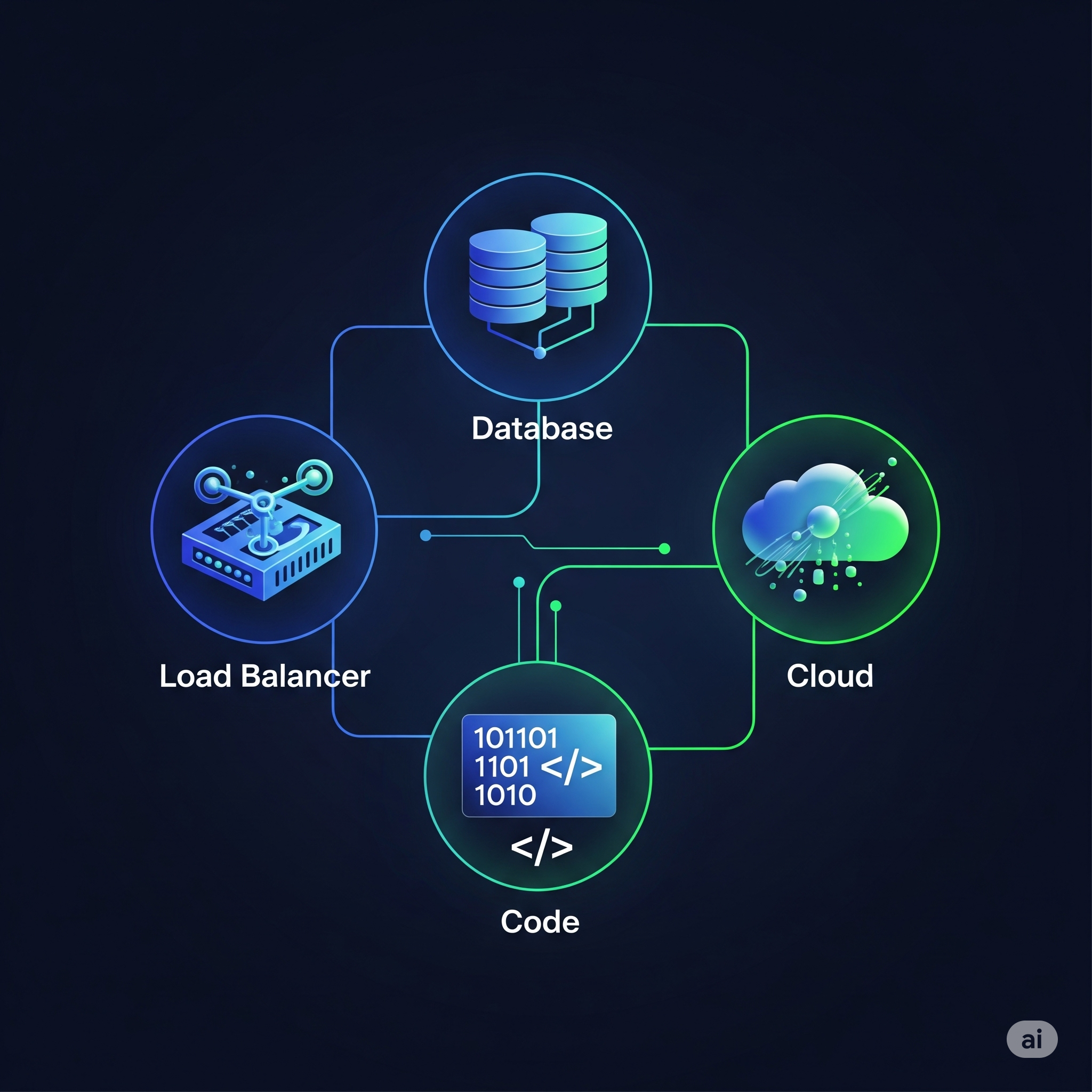DevOps engineer's guide to web application building blocks

Let's talk about the building blocks of web applications.
As DevOps engineers, our job isn't just about pipelines and infrastructure as code; it's also about understanding the systems we're deploying and managing. And that means getting under the hood of a web application to see what makes it tick.
You see, a web application isn't just one big blob of code. It's usually a collection of interconnected services and components, each playing a crucial role. Knowing these components inside out isn't just academic; it helps us make informed decisions about architecture, scaling, reliability, and security.
We need to be able to pick the right tools for the job, understanding that not every application needs every single component in the toolbox. It’s about fitting the right piece to the right puzzle.
Let’s explore about the most common components you'll encounter in modern web applications.
Load balancers
Think of a load balancer as the traffic cop for your application.
When you have multiple servers running your application, a load balancer distributes incoming network traffic across them. This isn't just for handling more users; it's crucial for high availability. If one server goes down, the load balancer simply directs traffic to the healthy ones, ensuring your application stays online.
It also helps in scaling horizontally – just add more servers behind the balancer.
Web application firewall (WAF)
A Web Application Firewall (WAF) is a kind of firewall that protects web applications from common web-based attacks.
It sits in front of your web servers and inspects HTTP/S traffic, filtering out malicious requests that exploit vulnerabilities like SQL injection, cross-site scripting (XSS), cross-site request forgery (CSRF), and other common threat.
A WAF acts as a crucial security layer, providing real-time protection before these attacks can even reach your application's business logic, adding a significant line of defense to your overall security posture.
While we denote WAF as a separate entity, you'll find that most load balancers have WAF function built in. So, in practical scenarios, your WAF and load balancer would be one box.
Reverse proxy
Often confused with load balancers (and sometimes they even share functionality), a reverse proxy sits in front of your web servers and forwards client requests to the web servers.
What makes it different from a load balancer?
It can do a lot more than just distribute load. You can use reverse proxy for:
- SSL termination
- serve static content directly
- compress responses
- cache frequently accessed data
- handling slow TCP sessions
- provide basic security features like protection against DDoS attacks.
Nginx and Apache HTTP Server are common choices here.
Database
This is the brain of your application, where all the persistent data lives.
Whether it's user profiles, product catalogs, or order histories, the database stores it. You've got your traditional relational databases like PostgreSQL and MySQL, fantastic for structured data and ACID compliance.
Then there are NoSQL databases like MongoDB, Cassandra, or Redis, which offer flexibility and can be better suited for large-scale, unstructured, or rapidly changing data.
Choosing the right database is a big decision, impacting performance, scalability, and data integrity.
Caching services
Databases, especially under heavy load, can become a bottleneck.
That's where caching services come in. They store frequently accessed data in a fast-access layer, often in memory, so your application doesn't have to hit the database for every single request. This dramatically speeds up response times and reduces the load on your database.
Redis and Memcached are industry-standard choices for in-memory caching. Implementing caching effectively requires careful thought about cache invalidation and consistency.
CDN
A Content Delivery Network (CDN) improves user experience, especially for users geographically far from your main servers.
CDNs store copies of your static assets—images, CSS files, JavaScript bundles, videos—on servers distributed globally, known as edge locations. When a user requests an asset, it's served from the nearest edge location, minimizing latency.
This makes your web application feel snappier and reduces the load on your origin servers. If you are hosting your web application on a single location but expect traffic from a global audience, a CDN is mandatory.
DNS
The Domain Name System (DNS) resolves your web site's URLs to the IP address that's serving your web application.
If you are running your web application on a server without any load balancers, this IP address would be the public IP of this server. If you have a load balancer sitting in front, your DNS records must point to your load balancers's public IP address.
If you employ a CDN, your DNS record must resolve not to an IP address but to the URL of the CDN service.
Don't let this simple description of DNS deceive you. There are nuances of DNS like types of DNS records, DNS zones, DNS caching and TTL, etc., you need to understand as a DevOps engineer.
We will be talking a lot about these in upcoming posts.
API gateway
For complex applications, especially those built with microservices, an API Gateway acts as a single entry point for all client requests.
Instead of clients needing to know the addresses of many individual services, they just talk to the API Gateway. It can then route requests to the appropriate backend service, handle authentication and authorization, perform rate limiting, transform requests/responses, and even aggregate responses from multiple services.
It centralizes cross-cutting concerns, simplifying client-side development.
Message queue/job queue
These are vital for building resilient and scalable asynchronous systems.
A message queue allows different parts of your application to communicate by sending and receiving messages without direct knowledge of each other. This decouples services, so if one service is slow or down, it doesn't block others.
Job queues are a specific use case where tasks (e.g., sending emails, processing images) are offloaded to be processed in the background, improving the responsiveness of your primary application. RabbitMQ, Kafka, and AWS SQS are popular examples.
Job queues are also a crucial components for handling traffic spikes—like Black Friday sales.
authentication and authorization services
Security is paramount.
Authentication is about verifying who a user is (e.g., username/password, social login), while authorization is about determining what that authenticated user is allowed to do.
These services often involve storing user credentials securely, managing sessions, issuing tokens (like JWTs), and enforcing access control policies. Implementing these correctly is critical for protecting user data and application integrity.
Sometimes authentication and authorization are handled by a dedicated service, other times it's integrated directly into the application's backend.
Monitoring and logging tools
Not strictly a part of the web application because these tools are not involved in serving the requests from your users.
But, you can't manage what you can't measure. So monitoring and logging is vital for any software application.
Monitoring tools (like Prometheus, Grafana, Datadog) collect metrics on everything from server CPU usage and network traffic to application-specific metrics like request latency and error rates. *
Logging tools* (like ELK Stack - Elasticsearch, Logstash, Kibana; or Splunk) collect all the logs generated by your application and infrastructure, providing a detailed trail of events.
Together, these give us the visibility needed to understand performance, troubleshoot issues, and ensure the health of our applications.
Wrapping up
So there you have it – a rundown of the common components that form the backbone of most web applications today.
As DevOps engineers, our job is to stitch these pieces together, automate their deployment, ensure their reliability, and monitor their performance.
The better we understand each component's role and how it interacts with others, the more effectively we can design, build, and maintain robust, scalable, and high-performing web applications.
Keep learning, keep experimenting, and keep those systems humming!

